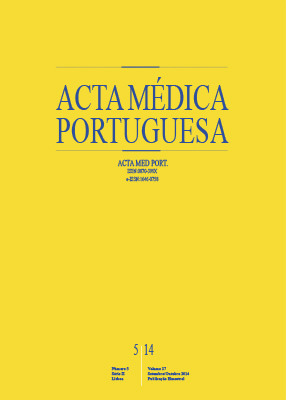Children who Leave the Emergency Department: Missing Opportunities?
DOI:
https://doi.org/10.20344/amp.4995Abstract
Introduction: Children who leave the Emergency Department may be at risk for preventable health problems related to the lack of timely assessment.
Objective: The aim of this study was to evaluate and characterize the cases of children leaving our Emergency Department and to determine their clinical outcome.
Material and Methods: A retrospective and descriptive review of the patient’s medical records was conducted. All children leaving the Emergency Department of Hospital de São Bernardo between January 1 and December 31, 2012, were included in the study.
Results: A total of 538 children abandoned the Emergency Department (1.35 % of all admissions). The majority (89.5%) had no criteria for urgent assessment and abandoned before medical observation (82.7%). The percentage of leaving was higher in the months of December, January and February (64%), on Tuesday (19.3%) and in the afternoon shift (60.8%). These periods coincided with the peak inflow of patients to the Emergency Department. The waiting time for medical observation was in most cases (94.4%) appropriate to the clinical severity. Six patients returned within 72 hours, 2 requiring hospitalization.
Discussion: The percentage of patients that walked-out from the Emergency Department was within the excepted range. A non-urgent triage level and prolonged waiting times were predisposing factors to abandonment.
Conclusion: Overcrowding of the Emergency Department with children with non-urgent problems, that increase waiting times, can lead to abandonment with unfavorable outcome, which in our series occurred in only 2 cases.
Keywords: Child; Patient Dropouts; Emergency Service, Hospital; Waiting Lists; Time Factors; Portugal.
Downloads
Downloads
Published
How to Cite
Issue
Section
License
All the articles published in the AMP are open access and comply with the requirements of funding agencies or academic institutions. The AMP is governed by the terms of the Creative Commons ‘Attribution – Non-Commercial Use - (CC-BY-NC)’ license, regarding the use by third parties.
It is the author’s responsibility to obtain approval for the reproduction of figures, tables, etc. from other publications.
Upon acceptance of an article for publication, the authors will be asked to complete the ICMJE “Copyright Liability and Copyright Sharing Statement “(http://www.actamedicaportuguesa.com/info/AMP-NormasPublicacao.pdf) and the “Declaration of Potential Conflicts of Interest” (http:// www.icmje.org/conflicts-of-interest). An e-mail will be sent to the corresponding author to acknowledge receipt of the manuscript.
After publication, the authors are authorised to make their articles available in repositories of their institutions of origin, as long as they always mention where they were published and according to the Creative Commons license.









